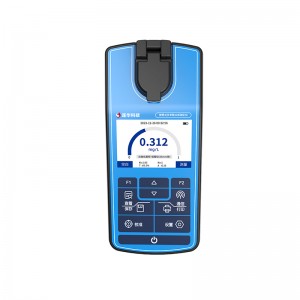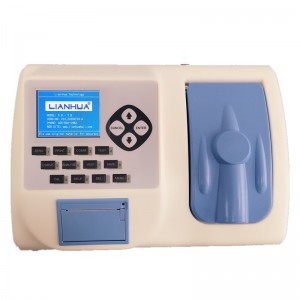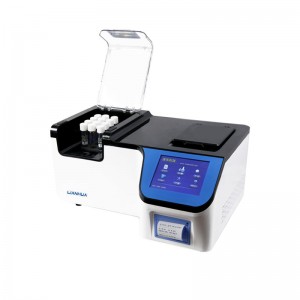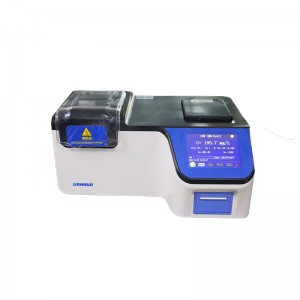C series portable multi-parameter water quality Instruments built-in battery and printer
Product Introduction
Lianhua C series is a water quality instrument for outdoor detection of users. It uses a spectrophotometry method and built -in lithium batteries. It is an instrument that integrates colorimeter and reactor. 7 inch touch screen, built-in printer.
Features
1) More than 38 items: direct analysis of chemical oxygen demand (COD), ammonia nitrogen, total phosphorus, total nitrogen, suspended solids, color, turbidity, heavy metals, organic pollutants and inorganic pollutants, etc. direct reading;
2) 360° rotating colorimetry: support 25mm, 16mm colorimetric tube rotation colorimetric, support 10-30mm cuvette colorimetric;
3) Built-in curves: 600 curves, including 480 standard curves and 120 regression curves, which can be called as needed;
4) Calibration function: multi-point calibration, support for making standard curves; automatically save calibration records, which can be called directly;
5) Recent mode: Intelligent memory of the 8 most frequently used measurement modes recently, no need to manually add selection;
6) Dual temperature zone design: 6+6 dual temperature zone design, 165°C and 60°C are simultaneously operated without interfering with each other, and independent work and colorimetry do not interfere with each other;
7) Permissions management: built-in administrators can set user permissions by themselves to facilitate management and ensure data security;
8) Portable in the field: Portable design, built-in lithium battery, with a professional accessory box, to achieve field measurement without power supply.
Specification
| No. | Test item | Analytical method | Range(mg/L) |
| 1 | COD | Rapid digestion spectrophotometry | 0-15000 |
| 2 | Permanganate index | Potassium permanganate oxidation spectrophotometry | 0.5-5 |
| 3 | Ammonia nitrogen-Nessler | Nessler's reagent spectrophotometry | 0-200(dilution) |
| Ammonia nitrogen-salicylic acid | Salicylic acid spectrophotometry | 0.02-50 | |
| 4 | Total phosphorus-ammonium molybdate | Ammonium molybdate spectrophotometry | 0-12(dilution) |
| Total phosphorus-vanadium molybdenum yellow | Vanadium molybdenum yellow spectrophotometry | 2-100 | |
| 6 | Total nitrogen | Chromotropic acid spectrophotometry | 1-150 |
| 7 | Turbidity | Formazine spectrophotometry | (0-400)NTU |
| 8 | Color | Platinum cobalt color system | (0-500)Hazen |
| 9 | Suspended matter | Direct colorimetry | 0-1000 |
| 9 | Copper | BCA spectrophotometry | 0-50 |
| Copper | Bathoxime spectrophotometry | 0.04-80 | |
| 10 | Iron | Phenanthroline spectrophotometry | 0-5 |
| 11 | Nickel | Dimethylglyoxime spectrophotometry | 0.1-40 |
| Nickel | Dimethylglyoxime | 0.04-60 | |
| 12 | Hexavalent chromium | Diphenylcarbohydrazide spectrophotometry | 0.01-5 |
| 13 | Total chromium | Diphenylcarbohydrazide spectrophotometry | 0.01-5 |
| Total chromium | Phenylhydrazine spectrophotometry | 0.01-10 | |
| 14 | Lead | Xylenol orange Spectrophotometry | 0.05-50 |
| 15 | Zinc | Zinc reagent spectrophotometry | 0.1-10 |
| 16 | Cadmium | Dithizone spectrophotometry | 0.1-5 |
| 17 | Manganese | Potassium periodate spectrophotometry | 0.01-50 |
| 18 | Silver | Cadmium reagent 2B spectrophotometry | 0-8 |
| 19 | Antimony | 5-Br-PADAP spectrophotometry | 0-12 |
| 20 | Cobalt | 5-chloro-2-(pyridylazo)-1,3-diaminobenzene spectrophotometry | 0.01-10 |
| 21 | Nitrate nitrogen | Chromotropic acid spectrophotometry | 0-250 |
| 22 | Nitrite Nitrogen | Naphthylethylenediamine hydrochloride spectrophotometry | 0.01-6 |
| 23 | Sulfide | Methylene blue spectrophotometry | 0.02-20 |
| 24 | Sulfate | Barium chromate spectrophotometry | 5-2500 |
| 25 | Phosphate | Ammonium molybdate spectrophotometry | 0.01-25 |
| Phosphate | Vanadium molybdenum yellow spectrophotometry | 6-3000 | |
| 26 | Fluoride | Spadns spectrophotometry | 0.05-20 |
| 27 | Cyanide | Barbituric acid spectrophotometry | 0.004-5 |
| 28 | Residual Chlorine | N, N-diethyl-1,4-phenylenediamine spectrophotometric method | 0.1-15 |
| Residual Chlorine | 0.05-50 | ||
| 29 | Total residual chlorine | N, N-diethyl-1,4-phenylenediamine spectrophotometric method | 0.1-15 |
| Total residual chlorine | 0.05-50 | ||
| 30 | Chlorine dioxide | DPD spectrophotometry | 0.1-50 |
| 31 | Ozone | Indigo spectrophotometry | 0.01-1.25 |
| 32 | Silicon dioxide | Silicon molybdenum blue spectrophotometry | 0.05-40 |
| 33 | Formaldehyde | Acetylacetone spectrophotometry | 0.05-50 |
| 34 | Aniline | Naphthylethylenediamine hydrochloride azo spectrophotometry | 0.03-20 |
| 35 | Nitrobenzene | Naphthylethylenediamine hydrochloride azo spectrophotometry | 0.05-25 |
| 36 | Volatile phenols | 4-aminoantipyrine spectrophotometry | 0.01-25 |
| 37 | Anionic surfactants | Methylene blue spectrophotometry | 0.015-20 |
| 38 | Hydrazine (hydrazine) | P-dimethylaminobenzaldehyde spectrophotometry | 0.015-10 |
| 39 | Methyl hydrazine | P-dimethylaminobenzaldehyde spectrophotometry | 0.015-25 |
| 40 | Unsymmetrical dimethyl hydrazine | Sodium aminoferrocyanide spectrophotometry | 0.05-20 |
| 41 | Total alkalinity | Methyl orange spectrophotometry | 20-400 |
| 42 | Magnesium hardness | Calcium magnesium reagent spectrophotometry | 0.1-80 |
| 43 | Calcium hardness | Calcium magnesium reagent spectrophotometry | 0.1-80 |
| 44 | Total iron | Phenanthroline spectrophotometry | 0.2-100 |
| 45 | Volatile fatty acids | Esterification spectrophotometry | 20-3600 |
| 46 | Chloride | Mercuric thiocyanate ferrocyanide spectrophotometry | 0.1-25 |














